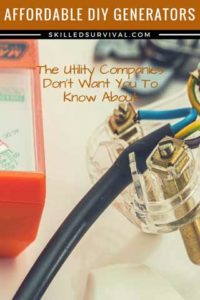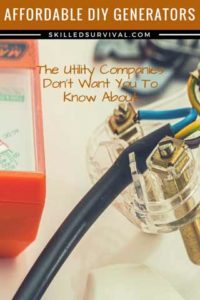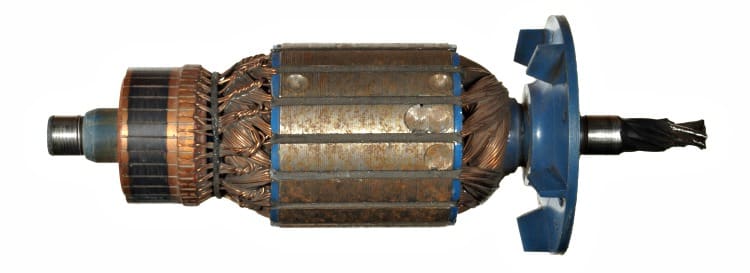 Affordable DIY Generators The Power Companies Don’t Want You To Know About…
Affordable DIY Generators The Power Companies Don’t Want You To Know About…
It would be impossible to list all the reasons to build a DIY generator.
- Maybe you’re preparing for a long-term emergency and want to generate your own power if the grid gets wiped out.
- Perhaps you dream of off-grid independence and self-reliance.
- Maybe you’d like to knock a few dollars off your electric bill or even get rid of it completely.
- Maybe you don’t feel like spending the money on something like the Bluetti AC200P (it’s worth every penny, by the way – you can see my Bluetti AC200P review here).
- Or maybe you want to do it for the pure joy of making functional science.
Regardless of your reason, the goal is always to produce and consume your own electricity.
Now, living off the grid doesn’t require electricity. Human beings have survived worldwide for tens of thousands of years without it.
It’s possible to make camp and sustain yourself without electricity.
- Instead of light bulbs, use candles.
- Forget the furnace; use the heat from a fireplace.
- Instead of an oven, use a wood stove and thick blankets.
You can make it with the right set of survival books and woodsman know-how.
But electricity makes life a lot easier, AND it makes life better.
For example, a refrigerator and freezer are very difficult appliances to live without in our modern society.
But electricity is a survival tool like any other. It’s just intangible and non-material. But extremely useful.
The applications are endless.
The best part is, building DIY generators does not require the intellect of Nicola Tesla. Or even a degree in electrical engineering.
DIY generators are extremely helpful tools. And they can even serve to increase the sustainability of your off-the-grid outpost.
Building your own generator is a skill that makes a huge difference in an “SHTF” situation. Even if you don’t make a DIY generator today, just knowing “how” is a valuable skill.
Are You Ready For The Tough Times Ahead? Take My 60 Sec Quiz To See If You’re Part Of ‘The Fragile Masses’ Or Not… Start Quiz Now!
 The Principals of Making Electricity
The Principals of Making Electricity
Before we get to the DIY generator builds, let’s s cover the general concept. Electric generators all share the same basic principles. So these are important concepts to understand.
Any time you use electricity, you use energy from somewhere else. Whether it’s a coal plant, running water, or wind, power comes from other forms of energy.
You convert one type of energy (wind, water, geothermal, combustion) into another (electricity).
So how do you turn the energy of moving water into electrical power stored in a battery?
How batteries work – Adam Jacobson
No matter the exact DIY generators you build, these two pieces are essential: The Stator and The Rotor.
The Stator is a stationary shell that houses the Rotor, which rotates inside of the Stator. The Rotor is filled with magnets, which generate an electric current as they spin.
That current is captured within the Stator’s built-in coils and transferred to the storage unit.
Now, you need a battery to store electricity from the Stator and the Rotor.
Basically, the larger the battery, the more energy you can store.
If you use your generator often, I recommend getting a large battery. One with a significant amount of energy storage potential. Or even better yet, a bank of batteries connected in series.
Small batteries are perfect if you want off-the-grid electricity to charge a camera and flashlight.
Building your own battery is possible. But I’d rather recondition an old battery back to life. It’s easier and less dangerous.
If you’re interested in learning how to recondition old batteries back to life, check out this EZ Battery Reconditioning Course.
As A Way To Introduce You To Skilled Survival, We’re Giving Away Our #78 Item Complete Prepper Checklist. Click Here To Get Your FREE Copy Of It.
Building Homemade DIY Generators – 8 Best Solutions
There’s more than one way to skin a cat, right? If you want DIY electricity, look to the sky, look to the sea, look at the ground, look in your garage…
The potential for electrical generation is everywhere.
This is good because no matter the situation, electricity generation is possible. You just need to understand how to harness it.
For this reason, I’ve compiled a very brief but comprehensive list of DIY generators.
1. The Bicycle Generator
I put this one first because it’s so simple.
By turning the gears (or wheel) of your bike, you turn it into a Rotor. So you can generate electricity and get a workout at the same time.
Need to boil some water? No problem, put in twenty minutes on the DIY bike generator, and you’re cooking!
Need a reading light? Pedal while you read, and you will have light for as long as you are on the bike!
Obviously, this requires physical labor. You won’t be heating a large household via a bike generator. But a bicycle generator is a healthy way to go if you need electricity for small, quick tasks.
You don’t even need a whole bike for this setup. You can build a DIY bike generator using old bike parts. So there is no need to dismantle your prized bug out bicycle.
Homemade Bicycle Generator Burn Calories and Make Electricity
2. Hydroelectric Generator
I will go ahead and call hydroelectricity the BEST option on this list. Because it’s reliable, it’s consistent, and it’s extremely effective.
Hydroelectric power has been in use for thousands of years. The ancient Greeks were first attributed to converting moving water into grinding wheat.
They were not using electricity, but they were harnessing energy. They turned running water into the useful task of making flour.
Which is exactly the concept behind generating hydroelectric power?
Water wheels are the most popular way of achieving hydroelectric energy. Positioning the wheel in the moving water transfers the motion of the water to the spinning wheel.
This wheel is then attached to the Rotor. And the energy is collected by Stator before being transferred to a battery.
Many streams and rivers flow at a near-constant rate. So hydroelectric energy is produced day and night, non-stop – effectively and efficiently.
Sadly, building and installing a functional hydroelectric plant yourself is complicated. Not impossible, but it requires a lot of foresight, preparation, and planning.
And, of course, you need a running body of water nearby too. So they’re not location independent, thus making them relatively rare.
Amazing 25+ Watts of Micro Hydro Power Off Grid
Did we make Hydro Power using Our Waterwheel for Self Reliance?
A lifetime of Free Power from Water
3. Wind Energy
The wind is one of your next best DIY Generator options.
The basic idea is the same – large blades capture the wind’s momentum and transfer it to a Rotor/Stator setup.
Unfortunately, wind turbines present a problem for the average Joe. They usually require ongoing upkeep and maintenance.
That’s why most large-scale wind farms have a team of highly trained, highly skilled engineers. They’ve been trained specifically to manage these wind turbines. But it’s becoming easier.
The most important aspect of setting up a wind turbine is investing in an efficient Rotor/Stator setup. A turbine setup that allows you to capture as much of the wind as possible.
However, this only really works in windy regions. Wind doesn’t do you any good if you live in a place where the air is perpetually still.
You need a lot of consistent, reliable wind if you want your DIY wind-powered electric generator to pay off.



 Affordable DIY Generators The Power Companies Don’t Want You To Know About…
Affordable DIY Generators The Power Companies Don’t Want You To Know About…
 The Principals of Making Electricity
The Principals of Making Electricity